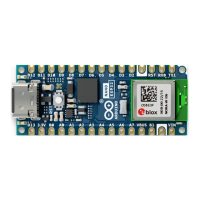8 Serial Communication Protocols
The ESP32-S3 chip provides flexibility for the various serial protocols it supports. For example, the I2C bus can be
assigned to almost any available GPIO.
8.1 Inter-Integrated Circuit (I2C)
Default pins:
A4 - SDA
A5 - SCL
The I2C bus is by default assigned to the A4/A5 (SDA/SCL) pins for retro compatibility. This pin assignment can
however be changed, due to the flexibility of the ESP32-S3 chip.
The SDA and SCL pins can be assigned to most GPIOs, however some of these pins may have other essential
functions that prevents I2C operations to run successfully.
Please note: many software libraries uses the standard pin assignment (A4/A5).
8.2 Inter-IC Sound (I2S)
There two I2S controllers that are typically used for communication with audio devices. There are no specific pins
assigned for I2S, this can be used by any free GPIO.
Using standard or TDM mode, the following lines are used:
MCLK - master clock
BCLK - bit clock
WS - word select
DIN/DOUT - serial data
Using PDM mode:
CLK - PDM clock
DIN/DOUT serial data
Read more about the I2S protocol in Espressif's Peripheral API - InterIC Sounds (I2S)

